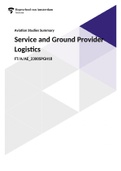Aviation Studies Summary
Service and Ground Provider
Logistics
FT/A/AE_2300SPGH18
, Blokhandleiding Aviation Studies
Week 1: Operations Management and the Airline Industry – Part 2
Third party logistics (3PL):
A third-party logistics company or 3PL in short, is a company’s use of other businesses to perform parts of it
operations or other business functions. It provides logistical services that a customer has outsourced to them. This
can be for all of their supply chain functions of just parts of it.
Some benefits include:
- 3PL’s can specialize in the integrated operation.
- Warehousing and transportation services can be scaled and customized to customer’s need.
Actual examples within Aviation are:
- Ground Handlers, Cargo Supply Chain, Warehousing/ Warehouse Management, Baggage system
Outsourcing:
Some goods or services can be outsourced, meaning that the company buys good or services rather than producing
the goods or performing the services themselves within the organization. This can:
- Reduce overhead.
- Gain flexibility.
- Take advantage of supplier’s expertise.
More reasons to outsource are:
- Transfer of risk.
- Can be cost saving.
- Can save valuable time.
- Access to expertise
- Allows you to focus on core processes.
- Better capacity management
- Better technology know-how
What can be outsourced?
You can outsource entire functions including HR, IT, accounting, marketing, market research. It is also an option to just
outsource parts of the function, like customer service or marketing. You can also choose to ‘’offshore’’ the operation,
which means moving the activities to another country.
Risk/disadvantages of outsourcing:
Financial costs - May have higher costs.
- Transaction costs: conducting negotiations, managing process, oversight of
supplier’s performance.
Loss of control - Possible loss in continuity of supply or quality control should the supplier not
perform as expected.
Loss of competitive knowledge - Companies lose ability to introduce new designs based on own agenda.
- Using serval suppliers may prevent the development of insights, innovations
etc. since solutions usually require cross functional teamwork.
Conflicting objectives - Your own business wants flexibility, whereas the supplier wants long term and
stable commitment.
Increase in risk - Loss of in-house expertise that might never be regained.
- Losing experts makes it more difficult to manage contract effectively
Domein Techniek
Hogeschool van Amsterdam
2
, Blokhandleiding Aviation Studies
Week 1: Operations Management and the Airline Industry – Part 3
Sales and Operations Plan:
The above title can be defined in two words: sales and operations plan.
Both terms are translated in airline terms whereby sales mean passenger tickets are sold or cargo booking have been
made. Whether Operations Plan are passenger/cargo flight schedules or baggage forecasts.
But how does the sales and operations plan establish?
Management sets objectives and makes a strategic plan. Based on the product and its marketing plan, production and
sales plans are drawn up, also known as the sales and operations plan (S&OP). The S&OP indicates the total volume
that should be generated. It provides management with visibility of production, inventory, ect.
S&OP structure
The sales and operations plan is, when
approved, translated into a ‘master
schedule’. This is the formal link between
production planning, and actual production.
It shows how much you need per item and
provides a calculation. Due to it being more
detailed than the S&OP plan, it is the driving
force behind the material requirements plan
and capacity requirements plan.
The S&OP integrates the business
management process. It achieves focus and
alignment among all functions. These
functions are the following: sales, production,
inventory, customer lead time (backlog), new
product development, strategic initiative, and
financial plan. It is routinely reviewed based
on customer demand and current supply
resources, and ‘’re-planned’’ when necessary.
Its primary focus is on future actions and
anticipated results.
Domein Techniek
Hogeschool van Amsterdam
3
, Blokhandleiding Aviation Studies
Week 1: Operations Management and the Airline Industry – Part 4
Stakeholders:
These are people and groups with legitimate interest in the operation’s activities. You can divide them into 2 groups:
- Internal stakeholders (employees)
- External stakeholders (customers, communities, shareholders, suppliers, regulators)
These are stakeholders in Aviation:
- Passengers, airlines, customs, GHA’s and Air Traffic Control.
Stakeholder What do they want from the operation? What does the operation want from them?
Shareholder - Return on investment. - Investment capital.
- Stability - Long term commitment
Directors - Low operating costs. - Consistent strategies.
- Secure revenue. - Appropriate investments
- Low risk of failure.
Staff - Fair wages - Attendance
- Good working conditions - Engagement
- Safe environment
Unions - Conformance with national - Fairness and understanding
agreements
Suppliers - Early notice of requirements - Integrity of delivery
- Long term orders and on time - Responsiveness and progressive price
payment reductions
Regulators - Conformance to regulations - Consistency
- Feedback - Responsiveness to industry concerns
Lobby groups - Honesty in marketing - No unfair targeting
- Practical help in achieving aims
Society - Minimize effects from noise, traffic - Support for future plans
ect.
- Jobs
Government - Conformance with legality - Low or simple taxes
- Contribution to economy
Typical stakeholders’ objective
Performance objectives for the operation can be divided into five categories:
1) Quality: : cleanliness, correctness, friendly and informed
2) Cost : staff, technology and facilities, material, and services
3) Speed : time kept to a minimum, fast deliveries, responsiveness
4) Dependability : No/few cancellations, on-time, predictability, consistency
5) Flexibility : Wide range of options, adjust to customer’s demands, frequency
Domein Techniek
Hogeschool van Amsterdam
4





